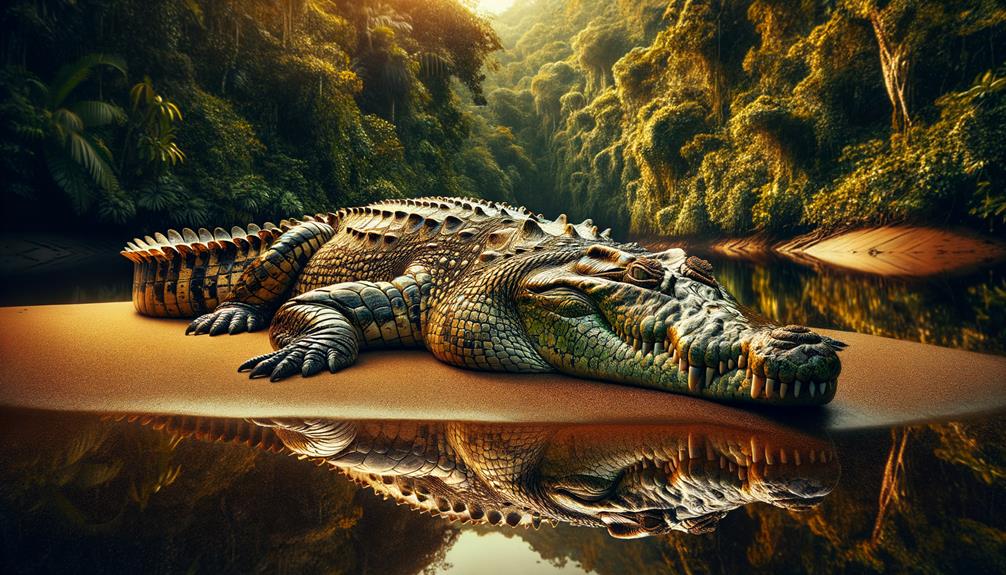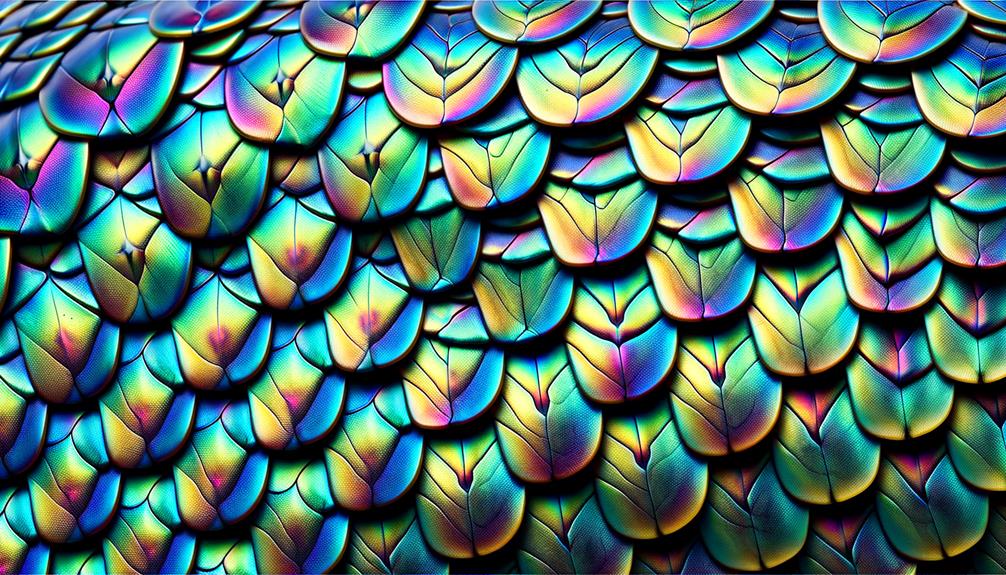I'm captivated by reptiles that thrive in Earth's most extreme environments. In the Arctic, the Siberian salamander has adapted to survive by producing antifreeze proteins. In the Himalayas, jumping spiders can be found at elevations as high as 22,000 feet. Sea turtles have streamlined bodies that enable them to hold their breath for hours while diving. The emerald tree boa in rainforests uses coiling behavior to regulate its temperature. On isolated islands like the Galapagos, giant tortoises have developed unique shell shapes suited to their specific environment. These remarkable adaptations showcase nature's incredible resourcefulness. By examining how each of these species thrives, we gain a deeper understanding of the wonders of evolution.
Key Takeaways
Siberian salamanders have adapted to survive the Arctic's extreme cold by producing antifreeze proteins.
Himalayan jumping spiders have made Mount Everest's extreme heights their home, living as high as 22,000 feet above sea level.
Sea turtles have evolved unique features, such as flipper-like limbs, which enable them to thrive in their ocean habitat and hold their breath for hours.
Emerald tree boas have developed a strategy to conserve energy and regulate their body temperature by coiling their bodies.
Galapagos tortoises have distinct shell variations that are tailored to their specific island habitats, showcasing their remarkable adaptability.
Desert Adaptations
This gives the reader a better understanding and makes the content
Arctic Survivors

Imagine a world where the biting cold is a constant companion, yet some remarkable creatures not only endure but thrive in these unforgiving Arctic domains. In this icy wilderness, life has adapted in extraordinary ways. For example, the Siberian salamander produces antifreeze proteins to prevent ice crystal formation, allowing it to survive temperatures as low as -22°F.
Arctic lemmings have developed remarkable survival tactics, burrowing under the snow to reach roots and bulbs, creating intricate tunnel systems that enable them to remain active throughout the harsh winter months. These underground havens are a lifeline in the relentless cold.
Ice crawlers, insect-like scavengers, have adapted to survive below-freezing temperatures in the Northern Hemisphere, showcasing nature's ingenuity in extreme habitats.
Gray-crowned rosy finches, hardy birds of the Arctic, breed on the slopes of Mount Denali, where they nest at some of the highest elevations in North America.
Some of the most fascinating Arctic survivors include the Siberian salamander, Arctic lemmings, ice crawlers, gray-crowned rosy finches, and mountain stone weta.
In the Arctic, life finds a way, proving that even in the harshest environments, resilience and adaptation prevail.
Mountain Dwellers

High up in the world's most formidable mountain ranges, creatures have developed extraordinary adaptations to survive in these extreme altitudes. The Himalayan Jumping Spider, for instance, can be found at elevations up to 22,000 feet on Mount Everest, where it relies on sharp eyesight to spot insects blown up the slopes.
In the Southern Alps of New Zealand, the Mountain Stone Weta, a giant flightless cricket, thrives in freezing temperatures. This remarkable insect can freeze and thaw with temperature changes, a remarkable feat that allows it to survive the harsh environment.
In South America, reptiles have adapted to conquer the Andean heights. These mountains host a variety of lizards that have evolved to endure the thin air and icy conditions. Their robust physiology and behavioral adaptations enable them to bask in the sun during the day and hide in crevices at night to escape the cold.
The adaptability of these mountain dwellers is truly remarkable. They demonstrate the spirit of survival, proving that life can flourish even in the most extreme conditions imaginable. Their stories showcase nature's ingenuity and resilience, highlighting the incredible diversity of life on Earth.
Aquatic Reptiles
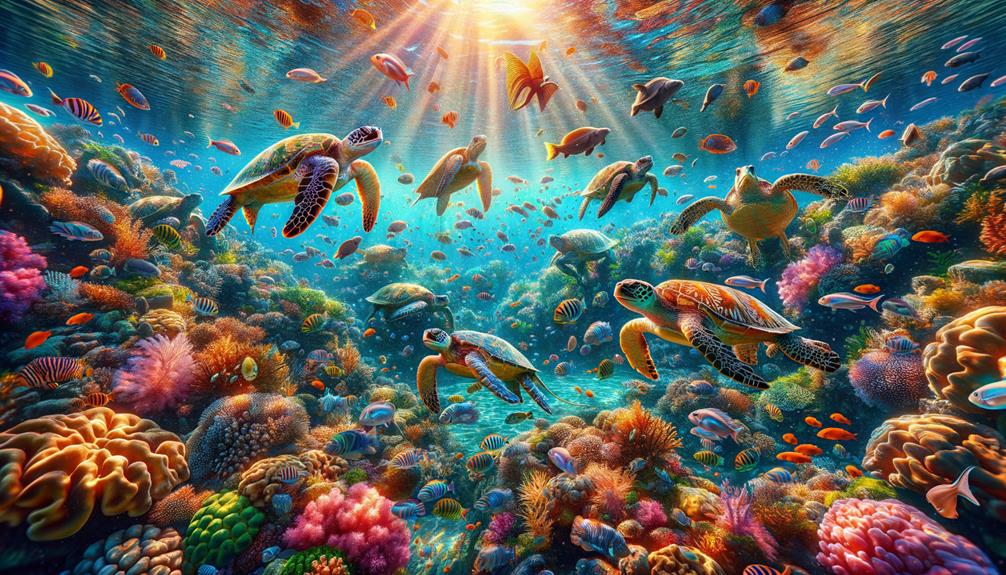
While many people associate reptiles with dry land, numerous species have adapted to life in water, showcasing an impressive range of specialized traits that enable them to thrive in the ocean. This adaptability highlights the incredible flexibility of reptiles and their ability to conquer diverse environments.
Sea turtles, for example, can hold their breath for hours and have flipper-like limbs perfect for swimming in the open ocean. Crocodiles and alligators found in national parks are skilled at regulating their body temperature in water, allowing them to inhabit both freshwater and saltwater habitats.
Marine iguanas, unique to the Galapagos Islands, have evolved to dive and forage for algae in the cold waters surrounding their volcanic homes. To survive, these reptiles employ various strategies:
They use countercurrent heat exchange to maintain body temperature. Their respiratory systems are adapted for prolonged submersion. They have efficient flippers and streamlined bodies for swimming. They can consume underwater vegetation or prey. They also have improved vision and olfaction for aquatic environments.
These remarkable creatures demonstrate the resilience of reptiles, capable of thriving in some of the most challenging aquatic environments on Earth.
Rainforest Inhabitants
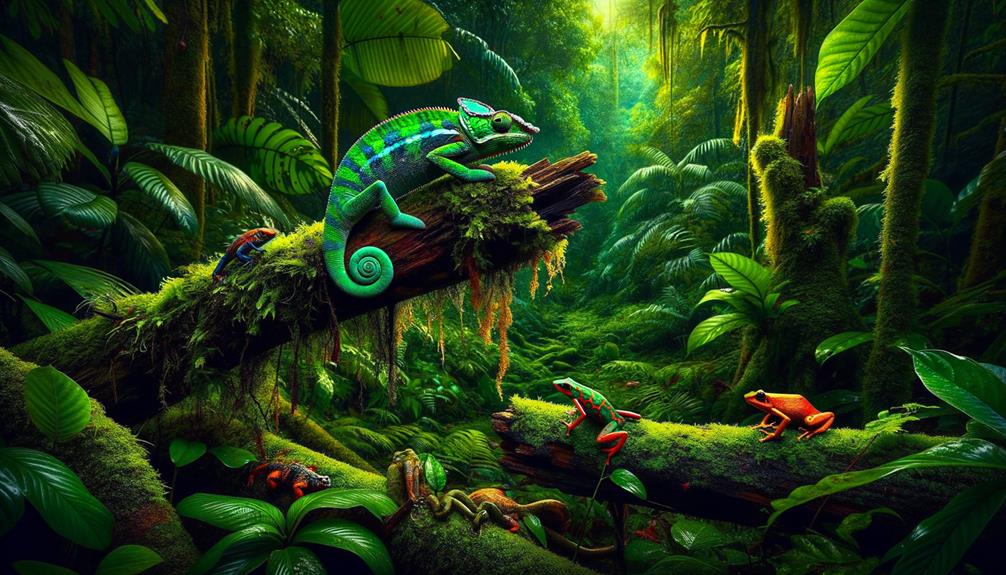
In the dense, humid rainforests, reptiles have developed remarkable adaptations to survive in one of the planet's most challenging environments. These adaptations are crucial for thriving amidst the intense heat and heavy rainfall, much like how creatures around hydrothermal vents adapt to extreme underwater conditions.
Take the emerald tree boa, for example. It coils its body tightly around tree branches, regulating its temperature and conserving energy within the dense canopy. The caiman lizard's sharp teeth and powerful jaws are perfect for cracking open the hard shells of prey like snails and mussels, thriving in the riverine habitats of the rainforest.
The red-eyed tree frog showcases large, sticky toe pads that allow it to cling to leaves and branches, evading predators in the multilayered forest. Each adaptation is a testament to the incredible resilience and ingenuity of these reptiles.
The inhabitants of the rainforest exhibit a fascinating range of survival strategies, similar to the diverse life forms around hydrothermal vents, demonstrating nature's boundless creativity in ensuring survival in extreme habitats. Each creature's unique adaptation is a marvel of evolution, making the rainforest a vibrant, dynamic ecosystem.
Island Specialists
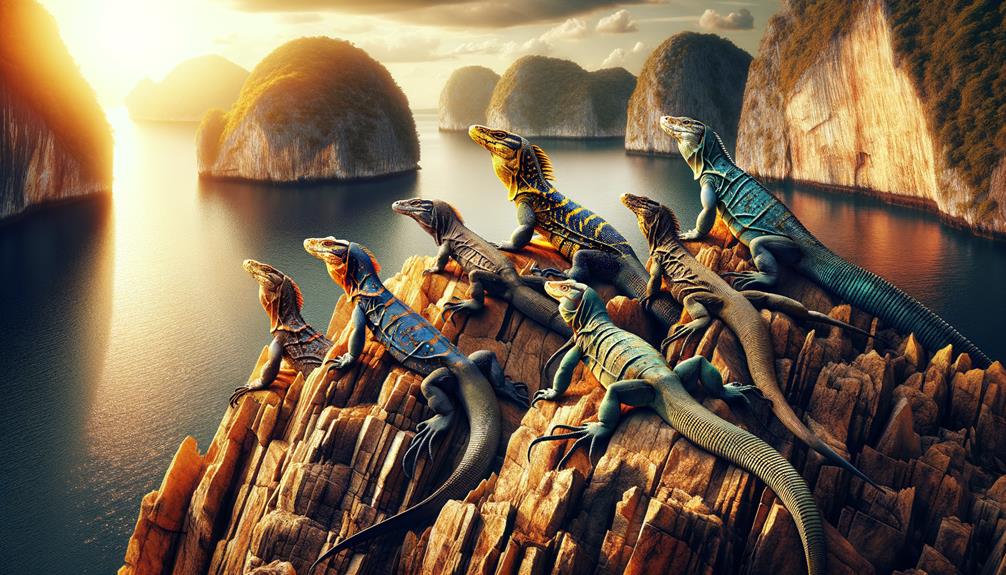
When I think about island specialists, I'm struck by their remarkable ability to adapt and survive in isolated, resource-scarce environments. With fewer predators around, these reptiles have developed unique diets and behaviors that set them apart. Take the Galapagos marine iguana or the Jamaican iguana, for example – their resilience and adaptability are truly impressive.
Adaptive Evolution Strategies
Island reptiles have evolved remarkable traits to thrive in their isolated and often extreme environments. These adaptations showcase nature's ingenuity in overcoming challenges. By examining various island species, we see the profound impact of these evolutionary strategies.
Take the Galapagos tortoises, for example. Each island's population displays distinct variations in shell size and shape, tailored to their specific habitats. Similarly, anole lizards on Caribbean islands have fine-tuned their toe pad size and limb length to optimize climbing on local vegetation, enhancing their mobility and survival chances.
The Canary Islands provide another fascinating example: skinks that have lost their limbs. This limb loss is a clear outcome of evolutionary pressures within their confined habitat, where streamlined bodies offer a survival advantage.
Insular dwarfism and gigantism are widespread phenomena among island reptiles. These size changes are evolutionary responses to limited resources and reduced competition, allowing species to thrive under unique island conditions.
Examples of these adaptations include:
- Galapagos tortoises: Shell size and shape variations
- Anole lizards: Toe pad size and limb length
- Canary Islands skinks: Limb loss
- Insular dwarfism: Reduced size in isolated environments
- Insular gigantism: Increased size in isolated environments
These adaptations reveal the remarkable resilience and versatility of island reptiles, embodying the spirit of freedom and survival.
Limited Predator Presence
The absence of predators on islands creates a unique environment where reptiles can thrive, free from threats that would otherwise limit their growth and behavior. On these islands, reptiles like the Galapagos marine iguana and Bermuda skink have evolved specialized traits not typically seen in mainland species. Without predators, they can grow larger and become more conspicuous, as seen in lizards on the Canary Islands and Madagascar that have abandoned camouflage.
Island reptiles often dominate their ecological niches due to reduced competition and predation pressures. The Komodo dragon, for example, has few natural enemies, allowing it to reign supreme in its isolated habitat. Similarly, the Cuban knight anole and the Bahamian iguana have capitalized on their predator-free environments to become the top species in their respective ecosystems.
Endemic species on remote islands like the Cayman Islands and Seychelles have developed unique adaptations, unimpeded by external threats. This isolation fosters an environment where specialized traits can flourish. The limited predator presence on these islands creates a sanctuary for reptiles, allowing them to thrive and evolve in ways that would be impossible on the predator-rich mainland.
Unique Dietary Habits
Reptiles on isolated islands have developed unique dietary habits, enabling them to thrive in environments often inaccessible to their mainland counterparts. The giant tortoises of the Galapagos, for instance, have adapted to a diet mainly consisting of low-energy plant matter, such as cacti and mangrove leaves. This diet supports their remarkable longevity, often exceeding 100 years. Meanwhile, lava lizards on the same islands have evolved dense scales and the ability to store water, allowing them to thrive in the arid, volcanic terrain.
Komodo dragons, found on Indonesian islands, are apex predators that rely on their keen senses and venom to hunt prey weighing over 300 pounds. They overwhelm their victims with a combination of physical strength and toxic bites. In contrast, introduced species like feral goats and pigs on remote Pacific islands have become generalists, consuming a wide range of plants and animals, often outcompeting native species.
Some key dietary adaptations of these island specialists include:
Giant tortoises mainly eat low-energy plant matter, such as cacti and mangrove leaves. Lava lizards have specialized to store water and developed dense scales. Komodo dragons prey on large herbivores, using their venomous bites. Feral goats and pigs are voracious generalists, consuming a wide range of plants and animals. Flightless rails and finches play a crucial role in seed dispersal and insect control.
These dietary strategies demonstrate the remarkable adaptability of reptiles in extreme habitats.
Frequently Asked Questions
What Is Something That Thrives in Harsh Conditions?
<|start_header_id|><|start_header_id|> ( content of your language reflects current events
What Animals Thrive in Extreme Heat?
I find Saharan silver ants absolutely captivating; their reflective silver hairs allow them to forage in scorching 160°F temperatures. The Pompeii worms are equally astonishing, tolerating a blistering 176°F in hydrothermal vents. These creatures have evolved unique adaptations to thrive in extreme heat.
What Animal Can Survive the Harshest Conditions?
I believe tardigrades are the champions of survival. These tiny creatures can withstand extreme temperatures, the harshness of space, and even high levels of radiation, making them incredibly resilient. Their ability to thrive in such conditions is truly astonishing and a testament to their remarkable adaptability.
What Are Organisms That Survive in Extreme Environments?
Here's a rewritten version of the text:
In the natural world, there are organisms that can survive in extreme environments. Take tardigrades, for example – they can withstand scorching temperatures. Camels, on the other hand, have adapted to thrive in the blistering heat of deserts. Penguins, meanwhile, have learned to persevere in the freezing cold of polar regions. Then there are extremophile bacteria that can brave the boiling temperatures of hot springs, and sharks that can survive in seas ranging from tropical to arctic. These organisms are the ultimate survivors, capable of thriving in conditions that would be deadly to most other living things.


